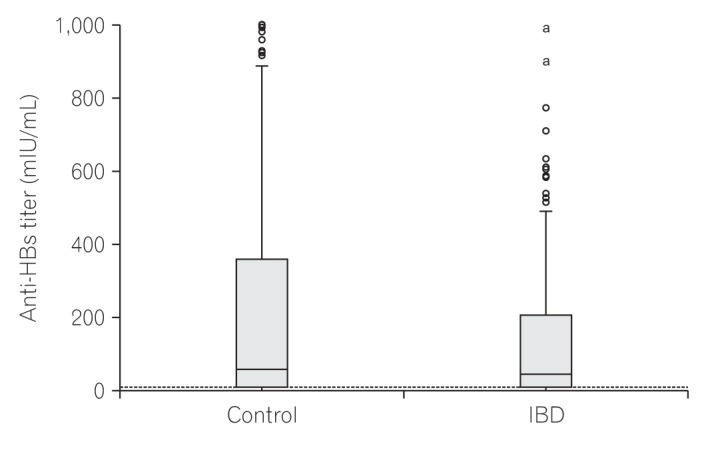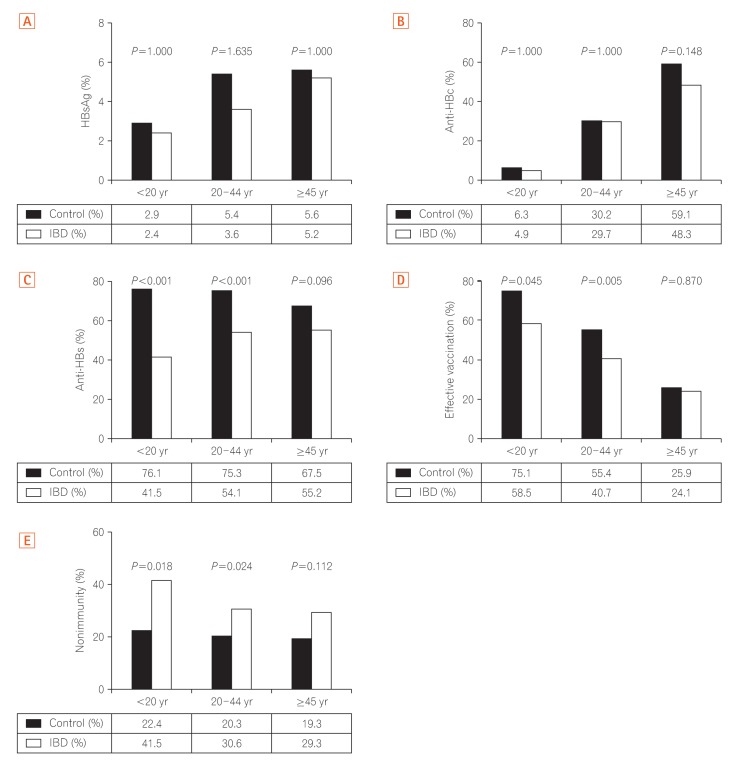Nonimmunity against hepatitis B virus infection in patients newly diagnosed with inflammatory bowel disease
- Affiliations
-
- 1Department of Internal Medicine, Kyungpook National University Hospital, School of Medicine, Kyungpook National University, Daegu, Korea. lhsworld@nate.com
- 2Department of Internal Medicine, Yeungnam University College of Medicine, Daegu, Korea. jbi@med.yu.ac.kr
- 3Department of Internal Medicine, Keimyung University School of Medicine, Daegu, Korea.
- 4Department of Internal Medicine, Daegu Fatima Hospital, Daegu, Korea.
- 5Department of Internal Medicine, Catholic University of Daegu School of Medicine, Daegu, Korea.
- 6Department of Internal Medicine, Dongguk University School of Medicine, Gyeongju, Korea.
- KMID: 2417652
- DOI: http://doi.org/10.5217/ir.2018.16.3.400
Abstract
- BACKGROUND/AIMS
This study aimed to elucidate the prevalence of hepatitis B virus (HBV) serologic markers in Korean patients newly diagnosed with, but not yet treated for inflammatory bowel disease (IBD).
METHODS
We prospectively enrolled 210 patients newly diagnosed with IBD (109 with ulcerative colitis and 101 with Crohn's disease). Hepatitis B surface antigen (HBsAg), hepatitis B surface antibody (anti-HBs), and hepatitis B core antibody (anti-HBc) levels were measured and compared with those of 1,100 sex- and age-matched controls.
RESULTS
The prevalence of chronic HBV infection (positive HBsAg, positive anti-HBc, and negative anti-HBs results) and past infection (negative HBsAg, positive anti-HBc, and positive or negative anti-HBs results) were not significantly different between the patients and controls (chronic HBV infection: IBD, 3.8% vs. control, 4.9%, P=0.596; past infection: IBD, 26.2% vs. control, 28.8%, P=0.625). The patients with IBD aged < 20 years were at a higher susceptibility risk (nonimmune) for HBV infection than the controls (IBD, 41.5% vs. control, 22.4%; P=0.018). In the multivariate analysis, an age of < 20 years (P=0.024) and symptom duration of ≥12 months before diagnosis (P=0.027) were identified as independent risk factors for nonimmunity against HBV infection.
CONCLUSIONS
The patients newly diagnosed with IBD were susceptible to HBV infection. The frequency of nonimmunity was high, especially in the patients aged < 20 years and those with a longer duration of symptoms before diagnosis. Therefore, it is necessary to screen for HBV serologic markers and generate a detailed vaccination plan for patients newly diagnosed with IBD.
Keyword
MeSH Terms
Figure
Cited by 3 articles
-
Prevention and management of viral hepatitis in inflammatory bowel disease: a clinical practice guideline by the Korean Association for the Study of Intestinal Diseases
Soo-Kyung Park, Chang Hwan Choi, Jaeyoung Chun, Heeyoung Lee, Eun Sun Kim, Jae Jun Park, Chan Hyuk Park, Bo-In Lee, Yunho Jung, Dong-Il Park, Do Young Kim, Hana Park, Yoon Tae Jeen
Intest Res. 2020;18(1):18-33. doi: 10.5217/ir.2019.09155.The importance of immunization in immune-mediated inflammatory disease cannot be overstated
Sang Hyoung Park
Intest Res. 2018;16(3):325-326. doi: 10.5217/ir.2018.16.3.325.Prevalence of hepatitis B virus and hepatitis C virus infection in patients with inflammatory bowel disease: a systematic review and meta-analysis
Suprabhat Giri, Dhiraj Agrawal, Shivaraj Afzalpurkar, Sunil Kasturi, Amrit Gopan, Sridhar Sundaram, Aditya Kale
Intest Res. 2023;21(3):392-405. doi: 10.5217/ir.2022.00094.
Reference
-
2. Kwon SY, Lee CH. Epidemiology and prevention of hepatitis B virus infection. Korean J Hepatol. 2011; 17:87–95. PMID: 21757978.
Article3. Yang SK, Yun S, Kim JH, et al. Epidemiology of inflammatory bowel disease in the Songpa-Kangdong district, Seoul, Korea, 1986-2005: a KASID study. Inflamm Bowel Dis. 2008; 14:542–549. PMID: 17941073.
Article4. Loras C, Saro C, Gonzalez-Huix F, et al. Prevalence and factors related to hepatitis B and C in inflammatory bowel disease patients in Spain: a nationwide, multicenter study. Am J Gastroenterol. 2009; 104:57–63. PMID: 19098850.
Article5. Chevaux JB, Nani A, Oussalah A, et al. Prevalence of hepatitis B and C and risk factors for nonvaccination in inflammatory bowel disease patients in Northeast France. Inflamm Bowel Dis. 2010; 16:916–924. PMID: 19885908.
Article6. Harsh P, Gupta V, Kedia S, et al. Prevalence of hepatitis B, hepatitis C and human immunodeficiency viral infections in patients with inflammatory bowel disease in north India. Intest Res. 2017; 15:97–102. PMID: 28239319.
Article7. Altunöz ME, Senateş E, Yeşil A, Calhan T, Ovünç AO. Patients with inflammatory bowel disease have a lower response rate to HBV vaccination compared to controls. Dig Dis Sci. 2012; 57:1039–1044. PMID: 22147248.
Article8. Vida Pérez L, Gómez Camacho F, García Sánchez V, et al. Adequate rate of response to hepatitis B virus vaccination in patients with inflammatory bowel disease. Med Clin (Barc). 2009; 132:331–335. PMID: 19268981.9. Melmed GY, Ippoliti AF, Papadakis KA, et al. Patients with inflammatory bowel disease are at risk for vaccine-preventable illnesses. Am J Gastroenterol. 2006; 101:1834–1840. PMID: 16817843.
Article10. Wörns MA, Teufel A, Kanzler S, et al. Incidence of HAV and HBV infections and vaccination rates in patients with autoimmune liver diseases. Am J Gastroenterol. 2008; 103:138–146. PMID: 17970833.
Article11. Lee KI, Park KS, Seo HJ, et al. Shifting in seroprevalence of HBsAg and anti-HCV during recent 10 years in adults resident in Daegu and Gyeongbuk province. Korean J Gastroenterol. 2011; 58:82–87. PMID: 21873822.
Article13. Moses J, Alkhouri N, Shannon A, et al. Hepatitis B immunity and response to booster vaccination in children with inflammatory bowel disease treated with infliximab. Am J Gastroenterol. 2012; 107:133–138. PMID: 21876562.
Article14. Tolentino YF, Fogaca HS, Zaltman C, Ximenes LL, Coelho HS. Hepatitis B virus prevalence and transmission risk factors in inflammatory bowel disease patients at Clementino Fraga Filho University Hospital. World J Gastroenterol. 2008; 14:3201–3206. PMID: 18506926.
Article15. Biancone L, Pavia M, Del Vecchio, et al. Hepatitis B and C virus infection in Crohn’s disease. Inflamm Bowel Dis. 2001; 7:287–294. PMID: 11720317.
Article16. Park SH, Yang SK, Lim YS, et al. Clinical courses of chronic hepatitis B virus infection and inflammatory bowel disease in patients with both diseases. Inflamm Bowel Dis. 2012; 18:2004–2010. PMID: 22337144.
Article17. Papa A, Felice C, Marzo M, et al. Prevalence and natural history of hepatitis B and C infections in a large population of IBD patients treated with anti-tumor necrosis factor-alpha agents. J Crohns Colitis. 2013; 7:113–119. PMID: 22464811.
Article18. Kim ES, Cho KB, Park KS, et al. Prevalence of hepatitis-B viral markers in patients with inflammatory bowel disease in a hepatitis-B-endemic area: inadequate protective antibody levels in young patients. J Clin Gastroenterol. 2014; 48:553–558. PMID: 24162170.
Article19. Song EY, Yun YM, Park MH, Seo DH. Prevalence of occult hepatitis B virus infection in a general adult population in Korea. Intervirology. 2009; 52:57–62. PMID: 19401629.
Article20. Watanabe R, Ishii T, Kobayashi H, et al. Prevalence of hepatitis B virus infection in patients with rheumatic diseases in Tohoku area: a retrospective multicenter survey. Tohoku J Exp Med. 2014; 233:129–133. PMID: 24898712.
Article21. Marusawa H, Osaki Y, Kimura T, et al. High prevalence of anti-hepatitis B virus serological markers in patients with hepatitis C virus related chronic liver disease in Japan. Gut. 1999; 45:284–288. PMID: 10403743.
Article22. He Y, Xu P, Chen Y, et al. Prevalence and influences of hepatitis B virus infection on inflammatory bowel disease: a retrospective study in southern China. Int J Clin Exp Med. 2015; 8:8078–8085. PMID: 26221373.23. Maul J, Loddenkemper C, Mundt P, et al. Peripheral and intestinal regulatory CD4+ CD25(high) T cells in inflammatory bowel disease. Gastroenterology. 2005; 128:1868–1878. PMID: 15940622.
Article24. Aalaei-Andabili SH, Alavian SM. Regulatory T cells are the most important determinant factor of hepatitis B infection prognosis: a systematic review and meta-analysis. Vaccine. 2012; 30:5595–5602. PMID: 22781305.
Article25. Jafarzadeh A, Shokri F. The antibody response to HBs antigen is regulated by coordinated Th1 and Th2 cytokine production in healthy neonates. Clin Exp Immunol. 2003; 131:451–456. PMID: 12605698.
Article26. Pallone F, Monteleone G. Interleukin 12 and Th1 responses in inflammatory bowel disease. Gut. 1998; 43:735–736. PMID: 9824592.
Article27. Filippelli M, Lionetti E, Gennaro A, et al. Hepatitis B vaccine by intradermal route in non responder patients: an update. World J Gastroenterol. 2014; 20:10383–10394. PMID: 25132754.
Article28. Wolters B, Junge U, Dziuba S, Roggendorf M. Immunogenicity of combined hepatitis A and B vaccine in elderly persons. Vaccine. 2003; 21:3623–3628. PMID: 12922091.
Article29. Averhoff F, Mahoney F, Coleman P, Schatz G, Hurwitz E, Margolis H. Immunogenicity of hepatitis B Vaccines: implications for persons at occupational risk of hepatitis B virus infection. Am J Prev Med. 1998; 15:1–8.30. Madonia S, Orlando A, Scimeca D, Olivo M, Rossi F, Cottone M. Occult hepatitis B and infliximab-induced HBV reactivation. Inflamm Bowel Dis. 2007; 13:508–509. PMID: 17206687.
Article31. Iannitto E, Minardi V, Calvaruso G, et al. Hepatitis B virus reactivation and alemtuzumab therapy. Eur J Haematol. 2005; 74:254–258. PMID: 15693796.
Article32. Law JK, Ho JK, Hoskins PJ, Erb SR, Steinbrecher UP, Yoshida EM. Fatal reactivation of hepatitis B post-chemotherapy for lymphoma in a hepatitis B surface antigen-negative, hepatitis B core antibody-positive patient: potential implications for future prophylaxis recommendations. Leuk Lymphoma. 2005; 46:1085–1089. PMID: 16019563.
Article33. Lee DS, Bang KB, Kim JY, et al. The prevalence and clinical characteristics of anemia in Korean patients with inflammatory bowel disease. Intest Res. 2016; 14:43–49. PMID: 26884734.
Article34. Suzuki Y, Iida M, Ito H, Saida I, Hibi T. Efficacy and safety of two pH-dependent-release mesalamine doses in moderately active ulcerative colitis: a multicenter, randomized, double-blind, parallel-group study. Intest Res. 2016; 14:50–59. PMID: 26884735.
Article35. Wu KC, Ran ZH, Gao X, et al. Adalimumab induction and maintenance therapy achieve clinical remission and response in Chinese patients with Crohn's disease. Intest Res. 2016; 14:152–163. PMID: 27175116.
Article36. Lee JW, Choi CH, Park JH, et al. Clinical features of active tuberculosis that developed during anti-tumor necrosis factor therapy in patients with inflammatory bowel disease. Intest Res. 2016; 14:146–151. PMID: 27175115.
Article37. Nakase H, Keum B, Ye BD, Park SJ, Koo HS, Eun CS. Treatment of inflammatory bowel disease in Asia: the results of a multinational web-based survey in the 2(nd) Asian Organization of Crohn’s and Colitis (AOCC) meeting in Seoul. Intest Res. 2016; 14:231–239. PMID: 27433145.
Article
- Full Text Links
- Actions
-
Cited
- CITED
-
- Close
- Share
- Similar articles
-
- Prevention of Viral Hepatitis and Vaccination
- Response to hepatitis B vaccination in patients with inflammatory bowel disease: a prospective observational study in Korea
- Evidence-based consensus on opportunistic infections in inflammatory bowel disease (republication)
- A Case of Ulcerative Colitis Following Acute Hepatitis Induced by Epstein-Barr Virus Infection
- Inflammatory bowel disease is no longer a risk factor of viral hepatitis infection in Asia



